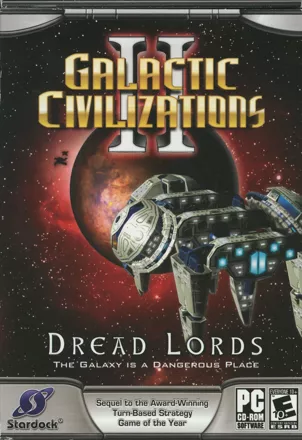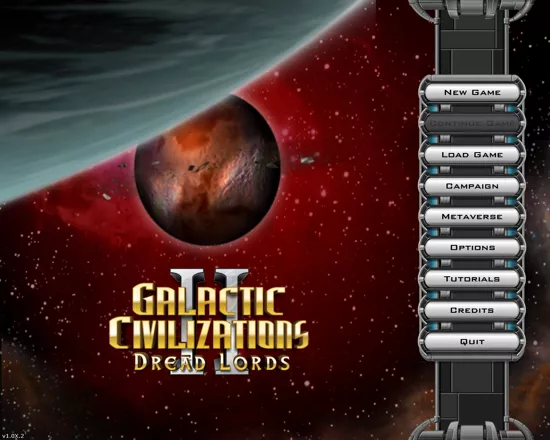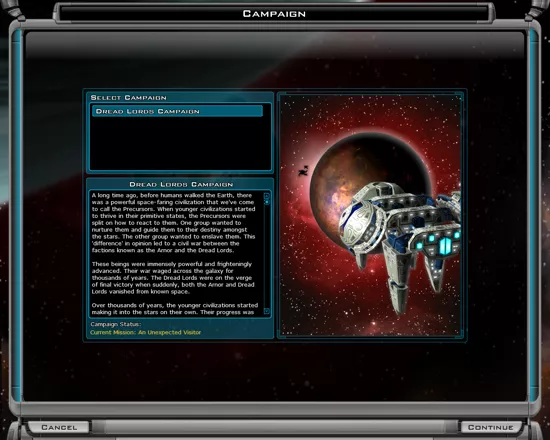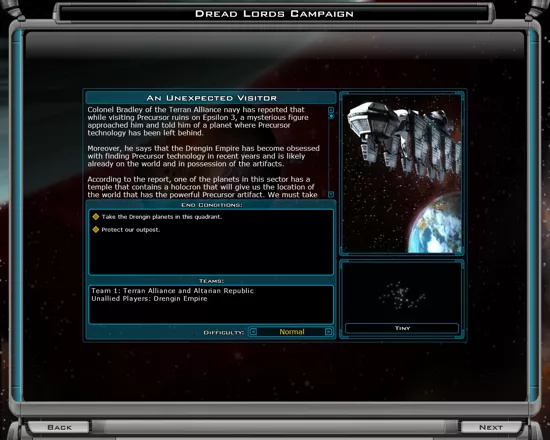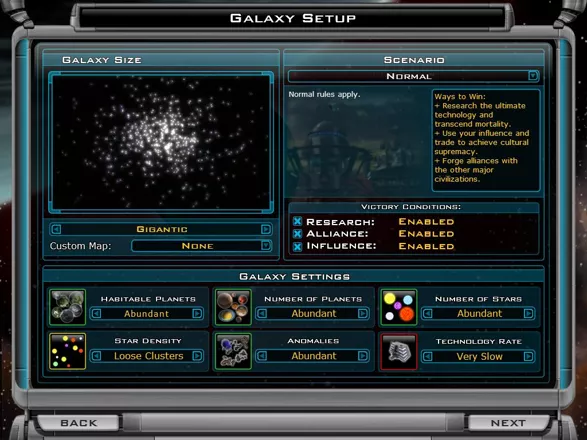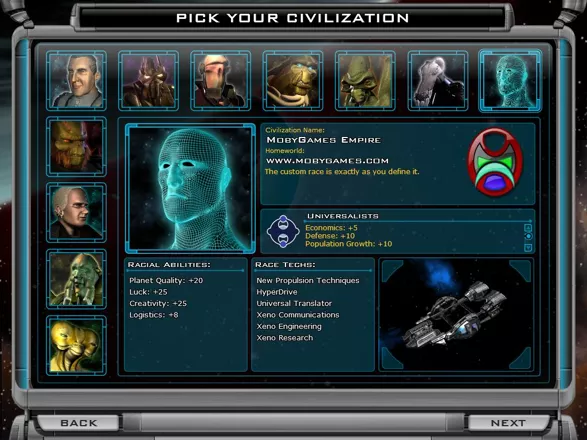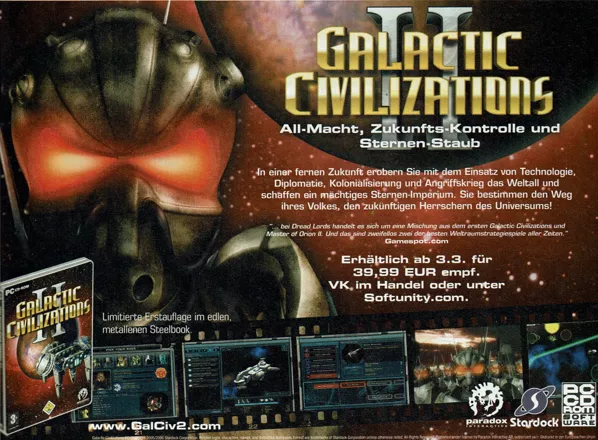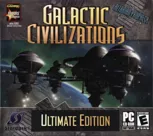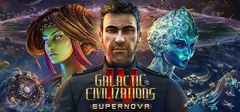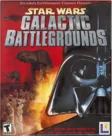Galactic Civilizations II: Dread Lords
Description official descriptions
Thousands of years ago, the highly advanced precursors split into two factions: The peace-loving Arnor and the paranoid war-like Dreadlords. They fought a great war in which the outcome was that both races disappeared from the galaxy. In the year 2225, the young Human race invents the Hyperdrive and a new age of expansion blossoms throughout the civilizations of the galaxy. Each of the various races wishes to create its own empire and bring prosperity to its people. Following the events of the first game and its expansion pack, the Humans and Altarans are united in an alliance against the Dregen Empire and The Yor Collective. Victory seems assured for the Human-Altaran fleets until information surfaces about an ancient artifact which may return the Dreadlords to this universe.
Galactic Civilizations II: Dread Lords is the sequel to the 2003 game and revisits the 4X space strategy of its predecessor. In the standard game the player will choose one of the ten major races in the game (or a custom race can be created) before setting out on an unexplored randomly-generated galactic map. Each race has its own strengths and weaknesses which give it bonuses in certain areas. As well, the controlling political faction of each race assigns bonuses. With planets and resources limited, the race to conquer the galaxy begins. Planets can be colonized, resources mined and fellow civilizations befriended or destroyed. Victory can be achieved through conquest (killing all other major races), diplomacy (being allied with every remaining major race), influence (influence controls 75% of the galaxy) or technology (researching Technological victory in the tech tree).
The game contains a highly customizable ship design feature allowing players to implement newly researched ship modules as they see fit. There is also a campaign mode beside the standard game, where a story of ancient Precursor civilizations unfolds mission-by-mission, and support for an online "Metaverse" where players can upload games to the website and be ranked against other players.
Spellings
- Космическая Федерация 2 - Russian spelling
- 银河文明II:恐惧之王 - Simplified Chinese spelling
Groups +
Screenshots
Promos
Videos
Add Trailer or Gameplay Video +1 point
See any errors or missing info for this game?
You can submit a correction, contribute trivia, add to a game group, add a related site or alternate title.
Credits (Windows version)
31 People · View all
| Designer & Product Manager | |
| Team Leader | |
| Lead Developer | |
| AI Developer/Economics | |
| Developers | |
| User Interface Designer | |
| Art & Animation | |
| Website Design | |
| Story & Elements | |
| Additional Story Elements | |
| Install | |
| [ full credits ] | |
Reviews
Critics
Average score: 83% (based on 26 ratings)
Players
Average score: 3.5 out of 5 (based on 23 ratings with 3 reviews)
An average copy-cat of Master of Orion that can't "meow" very well...
The Good
Game version: v1.0
Game mode used: Campaign
Game difficulty played: Suicidal
PC specs used: Intel Dual Core 2 1.86 Ghz. 1GB, 256MB NVIDIA 7300 LE.
So this is where Master of Orion went. After experiencing a very disappointing Master of Orion 3 which almost gave me a heart attack due to disgust, I almost gave up on 4x games. Until I came across Galactic Civilizations.
Well, this is my first experience with Galactic Civilizations. Not a very good first experience, but I'll save that for later.
I noticed that Galactic Civilizations is...er...Master of Orion. Really, this game is a total copy cat of Master of Orion...which can be good, or it can be bad...depending on how you developed it.
Can't really say much about the good, since it really is exactly like Master of Orion 2. Not much going on in the creativity department...let me tell you. Basically almost everything is the same, the ships, the technology screen, the galaxy interface. One would expect a little something more from a copycat. Apparently not.
The only difference in this game is that planets have tiles and thus limited areas to develop. Unlike Master of Orion where you can build any building you want in your planet, in this game you have to plan your planet due to the limited tiles and focus on what type of planet you want it to be: a economic planet, a industrial planet, a research planet, etc.
The only thing good worth mentioning is in this game, you can design your own ships. The physical attributes...merely just for display only since it doesn't effect the ship, but creating your unique type of ship (mine has a lot of horns) is extremely fun!
The Bad
Egad. I really hate it when they release a game that really shouldn't be released yet. The word "unfinished product" is something any consumer should never experience. And don't tell me that you can patch the game. If patching means making the game better, then I won't argue with you.
But if patching the game means fixing stuff they should've fixed in the first place (like bugs that constantly crash the game), then I totally protest. Stupidity should never be rewarded, appreciated nor ignored.
So here's the bad stuff.
Crash Bugs
Aaargh. I really hate it when this happens. In this version I have identified very annoying crash bugs among others:
Though ship design is the highlight (and the only thing different from Master of Orion) of the game, it is ultimately flawed. Why? The game lets you save ship designs which can be later used in any part of the game (or in my case, in mission scenarios of the campaign). The ship design will only show up again if you have discovered the same technology parts you put in that ship design. So if you saved the ship design with a Level 20 Laser gun for example, you have to get the similar technology first before you can access that design. Pretty stupid if you ask me, considering that you only want the ship's blue print that you designed for 30 minutes. Only to find out you have to design it again from scratch every time you start a new game. In game ship design also introduces slight problems. After adding like 30 components on the ship, you can't scroll through the components to the end, you can't quickly access important components like the weapons, modules or engines, making upgrades a very irritating process. Speaking of upgrades... Ship Upgrades
Another feature this copy cat game failed to utilize effectively. Upgrading ships is a nightmare in this game. You have to manually upgrade ships one-at-a-time, since the only other way to upgrade all the ships is when you save a ship design with the same name as the last. Which sometimes you don't want to do since [1] You want a different name [2] You don't want to upgrade all the ships since you get really broke after that. There is no way to upgrade the ships you want from a macro interface. You cannot upgrade ships that are in a fleet, you have to separate the ship from the fleet first. Boy this game is stupid. Combat, Fleets and More Stupid Stuff
Now this is the part where veteran gamers get really annoyed of copy cat games. First they copy it, then they take away the good stuff. What good stuff? They took away the tactical combat. In Master of Orion, you have turn-based tactical combat, which was really the focus of the game. In this stupid game, they took away the tactical combat. When you attack or are attacked by enemy ships, the combat is automatic. The attacker shoots first, thus having many tiny ships with big guns means you'll win fast. No brainer for combat here. Pretty boring after a while. A very quick while. Since having tiny ships with big guns usually do the trick in winning almost any battle. Having any other ship type is to a certain extent pretty darn useless. This has to do with “fleets”. Fleets is the action of combining ships into one big pool party. Without a fleet, a ship may only attack individually. The size of the fleet however depends on your logistics technology. So a logistics of 10 means you can have 5 tiny ships (tiny ships=2 logistics) in your fleet. Small ships = 3; Medium ships = 4; Large ships = 5, etc. You do the math. So when you have a fleet consisting of 10 tiny ships vs. a fleet with 3 large ships, if your attacking, it really doesn’t matter what weapons the defender has. You fire first and usually kill all or at least half of the enemy ships (depending on the technology the enemy has). In the end, armor, shields, and anything else of defensive value has little use in the game, since the best tactic is having a whole multitude of tiny ship fleets with big guns bringing anarchy to the galaxy. Another annoying feature in the game. You can’t bring fleets into orbit. For some stupid reason, every time your fleet enters a planet’s orbit, it disbands. Any you can only defend with one ship, unless your planet has a Fleet Manager improvement. Don’t know why they had to create this useless and irritating feature. In the end, you’d rather not have any of your ships orbiting your planet, except one ship to stop enemy troopships. Educational Value
This is where I draw the line. Someone fire whoever wrote all those stupid descriptions for technologies. I remember in Master of Orion, they created scientific explanations for every technology upgrade. Here its like it’s written by some high school drop out trying to sound funny. It only shows the shallowness of the developers involved in this project, since it doesn’t represent a passion of quality a passionate developer would take pride in creating games.
**The Bottom Line**
Well it's a copy cat. An average copy cat. One would expect more from a copy cat. But this game really can't meow very well. Be sure to patch the game.
Windows · by Indra was here (20735) · 2007
An Excellent 4X Game, an Excellent Way to Rule the Galaxy!
The Good
Galactic Civilizations II: The Dread Lords made me want to go give the latest civilizations game a try. There, I said it. I know a number of people, including family members, who now ant to kill me. Yes, it’s true, I always found Civ II (the one I played the most) to be annoying: I could never upgrade my throne room all the way (the best part of the game rally), and my civilizations would just start decaying way too fast. So, why should I have been interested in GC II, a 4X game (expand, exploit, explore, exterminate) that seems a lot like Civilization in space (as opposed to Alpha Centauri, Civilization on a Space planet!)?
The reason I showed interest in GC II, and the reason it was eventually gifted to me, is because of the ship creator. That should probably be where the review begins. The ship creator is absolutely stunning. The options available to you are beyond obsessive, beyond geeky. You can pick from an assortment of tiny, small, medium, large and capital ship hulls, and from there you just add on the parts. Parts come in two varieties, vital (weapons, engines, sensors, shields) and superfluous (really sweet looking fins and antennae!). This may not sound like much, but seeing a fleet of ships (all entirely of my own devising) lay waste to an enemy fleet is really something. I love naming them cool-sounding names from my gaming past: Scimitar class fighters, large frigates that are called, suspiciously, Tiger’s Claws. You can design literally any ship you want. There is an expansion pack (not reviewed here) that adds a whole new set of add-ons and designs for your ships. Trust me when I say you’ll be doing this for hours.
But what if you actually want to play the game?
You’ll start out the game with two singleplayer options: campaign or scenario. Campaign is alright, but these games have never had very interesting stories, and GC II is no exception. The real meat of the game is in the free play games. Here, you can choose one of several races, or make your own race. Preset races are appropriately different. You have your logical, hive-minded bug-aliens, your warlike pig-aliens, your robot mercantilist aliens. It’s all there. Each race has different strengths and weaknesses, different affinities for trade, espionage, diplomacy, research or war. You can also customize your fleet colors, which always takes me 20 minutes or so.
GC II offers a very fun, solid, and lengthy game experience. You start with one home planet, a colony ship, and your flagship. Go exploring! The only way to win in this game is to expand your empire. Players who try to stay on one or two planets will be instantly smashed. Planets are the key to more resources, more bases, more population, more influence. Just about more of everything.
The reason that I love GC II (besides those beautiful ships) is because of its options. You can win in many different ways. You can use might to conquer and enslave the galaxy, you can acquire such amazing technology that all bow down before your knowledge, and you can unite all races in A United Federation of Planets kind of way. My favorite, however, is the Cultural victory. This means that you win because your culture is so vibrant, impressive, rich and enthralling that other star systems literally join your cause because they want to be part of the coolest culture ever. Awesome!
To leave my description of the game in this fashion would be selling it short. There are dozens of building options, a multi-tiered research tree that allows you to learn anything from mercantilism to republicanism to warp drive to mass driver guns. You can change the ways in which you allocate funds and tax the people. You can change governments, create a galactic senate, or leave that same senate and wage war on all other races. You can spy on your enemies and negotiate peace treaties, or bombard their planets and pulverize their fleets.
Sure, you can do all of these things in other forms, in other games, but GC II is so very addictive, it puts other games to shame. I have stayed up till 5am playing this game. You just keep on building, and expanding, and creating amazing ship designs. What more can I say; this game is fun, deep and addictive.
The Bad
There are a few blemishes on the otherwise pristine face of this game. First, as I mentioned before, you absolutely must expand at the beginning of the game. What this means is that the first few hours of every game devolve into a crazy race to claim planets. It gets annoying, and there is nothing you can do about it. Next up is the tech tree. Yes, it may be deep (there are about 15 levels of lasers), but after the 13th level of neutron shields, you get bored. The same goes for other tech tress, which involve some repetition from time to time.
Even more disappointing are the espionage and diplomacy sections. Espionage consists of paying a certain amount to “increase” your espionage level on a race. This means you can allocate 5 space dollars a month to espionage on the Drengins (Klingons, essentially), and with absolutely no effort on your part you’ll soon no everything about them. The same goes for diplomacy. All you do here is make trade deals and alliances, which raise or lower other races opinions of you. It’s simple and shallow.
The final and worst offender is space combat. It is true that I can make tons of cool spaceships, but spaceship battles look bad. Like the original Wing Commander bad. You’ll start skipping combat after battle number two, trust me. Oh, and the races may have different abilities, but they all research the same stuff. This significantly decreases replay options.
The Bottom Line
GC II is fun, engrossing and ultimately flawed. But there is hope. The expansion, Death Guys, makes changes to almost everything I mentioned. Tech trees are diversified (think racial super abilities), graphics are improved, space combat looks and plays in a more interesting way, the rush for new territory is changed and slowed, new factions are added; there really isn’t a problem that they didn’t address. Oh, and did I mention that the expansion adds tons of new ship designs and parts?
Windows · by Tom Cross (28) · 2008
The Good
First of all, let me point out that I've never played MOO (Master of Orion) or Galactic Civilizations I, although I've had some experience with other titles in this genre such as Space Empires IV and Emperor of the Fading Suns. Being a jaded gamer that is hard to impress, I didn't expect much from GalCiv2 and for this reason I put off purchasing the title for a few months. Boy was I missing out!
GalCiv2 is a game of the 4x genre, the 4x being eXplore, eXpand, eXploit, and eXterminate as the overall objects of the game. Based in outer space, you begin your humble civilization with 1 planet and its up to you to build your civilization from there. However, before this happens there is the setup of parameters for the type of game you wish to play. GalCiv2 does a great job of providing for diversity in game options and therefore creates almost limitless replay value. You may select the size of the galaxy, the frequency of habitable planets, anomalies, number of opponents (up to 9) and so forth. A wide range of difficulty levels also provide for fine tuning to allow for beginning players of various levels, all the way to advanced bone crunching difficulty levels for the seasoned veterans.
One of the most important options when beginning a new game is to determine which kind of parameters are enabled that can provide for victory. In other words, there are multiple paths to winning the game be it through technology, conquest, alliances, or cultural influence. You can disable all of these options except conquest, or activate any combination of the other three choices. Being that most games require you to destroy your enemy, I like to turn on all of the other options and work towards winning the game by means other than pure conquest.
Having selected game parameters, it's time to choose your race. Your race can be one of the pre-defined included in the game (there are 9 of them) or you can create your own. Creating your own race is exciting, and you're able to tweak everything from starting technologies, political parties, to racial attributes. There are probably millions of combinations that exist to suit strategists of all alignments and backgrounds. With these options, never have I seen a game that offers almost unlimited replay value such as this one. To top things off, there is also a campaign mode although I haven't tried it yet as I've been consistently playing in 'new game' mode, starting one as soon as I finish the last.
In starting off the game, it's important to build your first colony as to be efficient in civilization growth. Focusing on military expenditures at this point will only set you back, and you'll need to focus on social and research projects to gain enough momentum to build you treasury, establish your research and manufacturing base, and expand your population levels. Early in the game you'll have a planet close to you of a lower quality that you can settle on to as well. Aside from colonizing your neighboring planet and taking care of the aforementioned things, there isn't much to do early in the game, and you'll find clicking the 'turn' button to start a new turn and speed the research and population growth along.
When settling planets, they are rated as Class 0-15+. 0 is uninhabitable, 10 is like planet Earth, and 15 is like a utopia of sorts. It is possible to go higher than Class 15 but only through planetary improvements which require a high technology obtained later in the game. With each of your planets you're able to focus on either research, military, or social endeavors. Focus on social and new structures get built really fast, but it takes forever to build ships. Focus on research and you speed up the discovery of new technologies but at the cost of social and military production. You can tweak these settings for each individual planet or you can tweak your entire civilization at once by dictating civilization wide spending on any of these three categories. On the same screen you can determine things like spending towards industrial capacity and the tax rate. These are important especially when considering that each planet also has an approval rating that you must keep high in order to avoid revolts or lost production should you advance to a form of government other than dictatorship. Military spending lowers approval, and while lowering taxes is a quick fix, chances are that you'll need to improve the planet's conditions for long term approval. What's great about this is that you can treat each planet as an individual colony or you can control the dynamics of your entire civilization from one screen. Being that no two colonies are really the same, I find far more success in controlling each individual colony rather than making a blanket policy for my entire civilization.
From time to time you’ll also be presented with decisions to be made about randomly occurring events. These decisions can help determine your ethical alignment, which can play a role in diplomacy with the AI. If you tend to be more evil, good civilizations will dislike you, and vice versa. These random events often have a level of humor involved which add some personality to the game.
While you do not control what happens during combat, you are in control (usually) of what is happening prior to combat. The important decisions and skill in the game are picking your battles, or preparing for them. Once the fight starts, you have no control over the outcome. However, you do get to watch the battle unfold on the screen with multiple viewpoints and camera angles. Watching the battle can help you determine which upgrades for combat ships are effective, and which aren’t. But hey, it’s a strategy game, not a shoot’em up.
The Bad
There are some minor annoyances that come to mind, but nothing too serious.
For one diplomacy is weird. If a race is much more powerful than you, they will usually have little to do with you in terms of trades or research swapping, even if you have something they need. On the other hand if you are a very powerful race smaller, less threatening empires will roll over for you. I’ve had smaller empires that I was friendly with suddenly retire and relinquish to me all over their colonies. This was annoying. To make matters worse, if you and an opposing computer player were the top dogs competing for control, often the balance of power shifts suddenly because some smaller empire will spontaneously surrender to you, or them throwing the balance all out of whack.
There were a few crashes to desktop, but after 50 hours of play I only experienced 3 and it seemed to be random as I could not duplicate the crash when I tried to.
My biggest complaint of all; NO MULTIPLAYER. This is almost unacceptable. Even a PBEM or hot seat option would be spectacular. The fact that the game mechanics are so solid, and the replay value so high, I am forced to overlook this, begrudgingly (hey even Emperor of the Fading Suns had multiplayer).
The Bottom Line
The bottom line? The bottom line is this; GalCiv2 is one of, if not THE best turn based strategy games I’ve ever played. With scalable AI, solid game mechanics, and remarkably sophisticated strategy elements, I challenge fans of the 4x genre to find anything else that comes close. Enjoy this one!
Windows · by D Michael (222) · 2006
Trivia
1001 Video Games
Galactic Civilizations II: Dread Lords appears in the book 1001 Video Games You Must Play Before You Die by General Editor Tony Mott.
References
In the campaign mode of the game, the mission titled "Siege" starts the player with three planets named: Sabin, Celes and Locke. The names are references to three of the main characters of Final Fantasy III.
StarForce
When the game was released and topped the American charts, without relying on copy protection, a StarForce administrator, working for the StarForce company providing copy protection for media, posted a torrent link to an illegal version of the game on the company's forum, with the message:
Right now several thousands are downloading the pirated version from that web-site. Is it good for the sales? Unlikely. Good game [sic] surely would have the high sales rate even if it doesn't have any copy protection, but not because of that. Good protection is the tool, which increases the rate.
The offending post was soon removed, but this move raged gamers worldwide, accusing StarForce of relying on mafia-style blackmail activities to run its business.
Awards
- Computer Games Magazine
- March 2007 - #6 Game of the Year 2006
- Games for Windows Magazine
- March 2007 - #3 Game of the Year 2006
- GameSpy
- 2006 – #6 Game of the Year
- 2006 – PC Turn-Based Strategy Game of the Year
Analytics
Related Sites +
-
Galactic Civilizations II: Dread Lords
Official website
Identifiers +
Contribute
Are you familiar with this game? Help document and preserve this entry in video game history! If your contribution is approved, you will earn points and be credited as a contributor.
Contributors to this Entry
Game added by Kilmaat.
Additional contributors: Unicorn Lynx, Jeanne, tarmo888, Sciere, jaXen, COBRA-COBRETTI, Stratege, Patrick Bregger, Plok, FatherJack.
Game added April 27, 2006. Last modified January 6, 2025.


